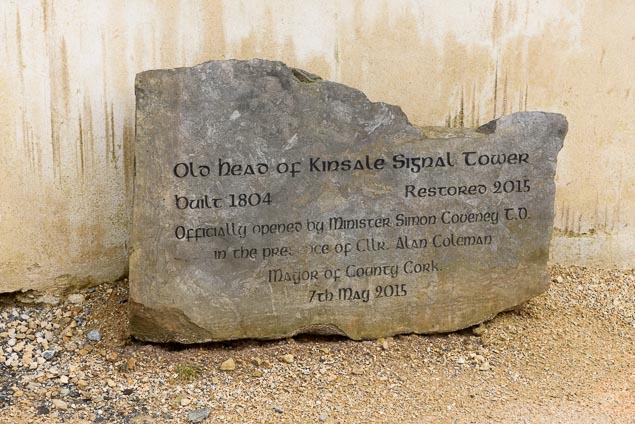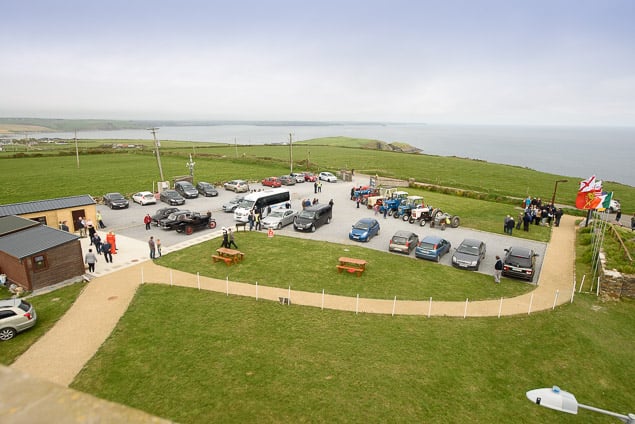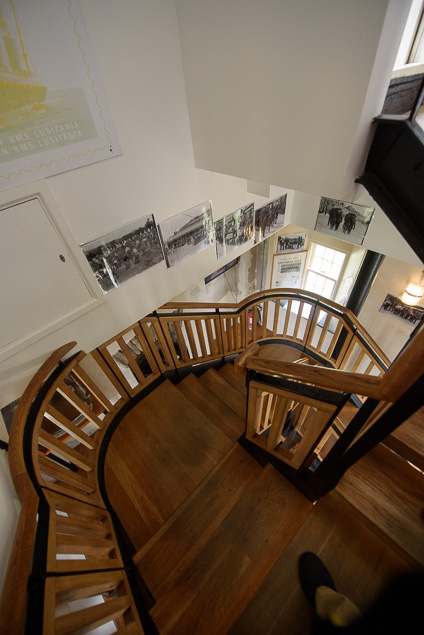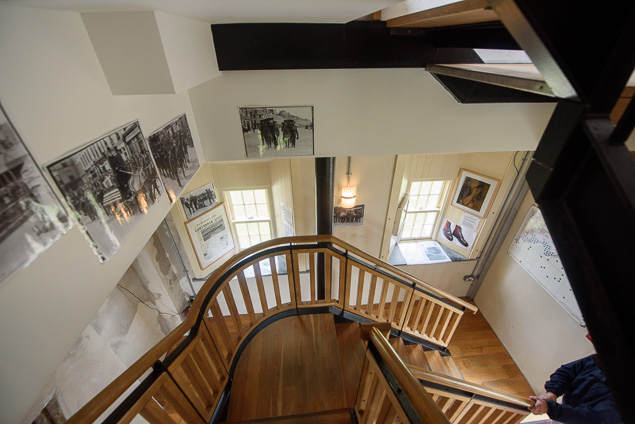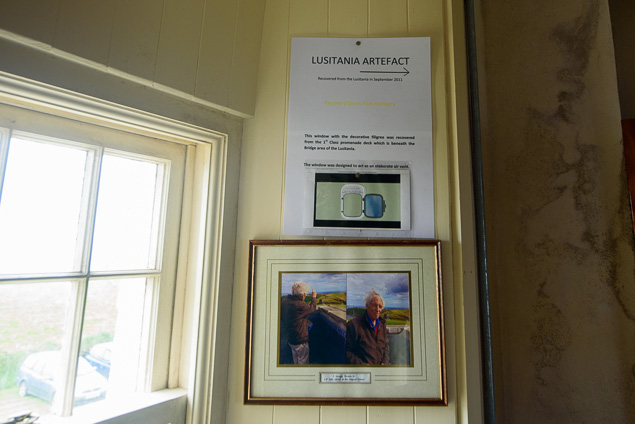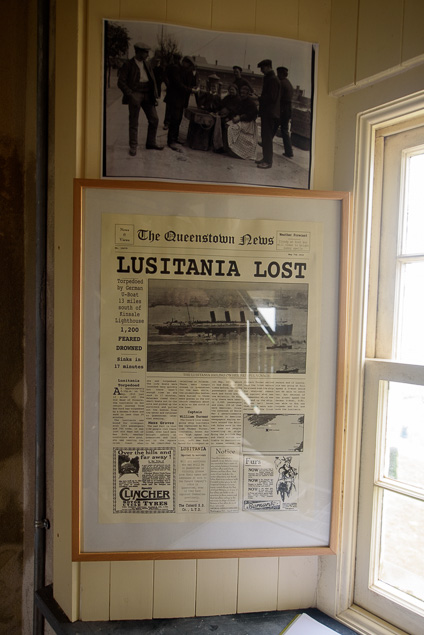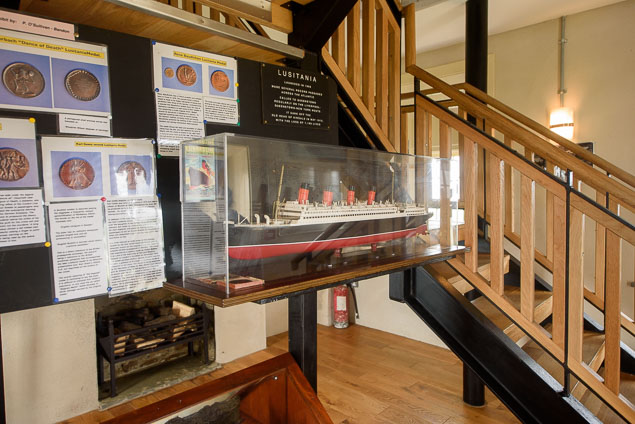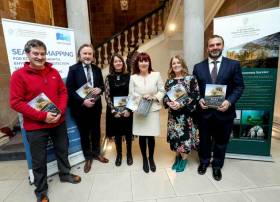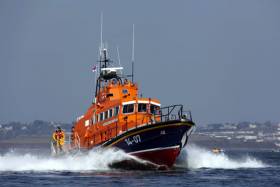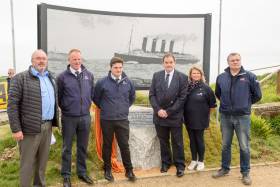Displaying items by tag: Lusitania
RNLI’s 200 Voices Podcast Shares Story of How Lusitania Disaster’s Youngest Survivor Sparked a Family’s Lifesaving Legacy
The RNLI’s 200 Voices podcast talks to Mark Hudson — grandson of Audrey Lawson Johnston, the youngest survivor of the Lusitania disaster — on his family’s remarkable story that ignited a life-long passion and commitment to helping save lives at sea.
In episode 61 of the podcast series, which explores captivating tales from the history of the charity that saves lives at sea through to the modern day, Mark recounts that fateful night in 1915 and its impact on his great-grandparents and granny Audrey.
On 7 May 1915, en route from New York to Liverpool, the passenger liner Lusitania was torpedoed by a German submarine off the coast of Cork. The vessel sank within 18 minutes and 1,200 lives were lost.
Against the odds, Mark’s granny Audrey, who was just three months old at the time, survived along with her mother Amy Lea, father Warren, brother Stuart and one of the family’s nursemaids, 18-year-old Alice Lines.
Mark explains the chaos of his granny’s rescue once the torpedoes had hit the ship: “Alice grabbed Audrey and Stuart and ran to the deck to try and get in a lifeboat. The ship was listing dramatically, a lifeboat was lowered… she jumped off the side to try and land in it, holding my granny in her arms and Stuart by the hand.
“They landed in the water and were pulled into a lifeboat and were saved that way.”
Courtmacsherry RNLI volunteers rowed for more than three hours to reach the area in an attempt to help with the rescue operation.
Mark said: “They had no motor and no wind and the RNLI spent three-and-a-half hours rowing to the scene. By the time they got there any survivors had been picked up, so they then spent eight hours recovering bodies.”
Sadly, Audrey’s sisters Susan and Amy, along with the family’s second nursemaid Greta Lorenson, were never found.
This pivotal moment in the family’s life became the start of their long association with the RNLI.
“We can’t find out how much my great granny [Amy Lea] did for the lifeboats, but the whole family became very involved for obvious reasons. It’s said she always raised money for the lifeboats which she passed onto granny,” Mark said.
Amy Lea was in fact pregnant when she survived the sinking of the Lusitania and eight months after the tragedy, Vivian ‘Perky’ Warren Pearl was born.
Perky and Audrey continued their mother’s dedicated fundraising for the lifesaving charity and in 2004 they raised enough money for a new D class lifeboat, which they named Amy Lea.
Amy Lea became New Quay RNLI’s inshore lifeboat, which went on to aid 93 people and save four lives during its operational service.
‘One thing my granny used to say was, “I was saved for a reason and this is it” and that’s what she said when she dedicated the Amy Lea’
This wasn’t the only lifeboat funded by the family. Led by Mark’s father Martin and his brother Hugh, they raised enough money for New Quay’s next inshore lifeboat, naming it Audrey LJ.
When Amy Lea was retired, Audrey LJ came on service and is still operational today, although soon to be retired at the end of this year. During its service, Audrey LJ has launched 189 times, aided 150 casualties and saved the lives of six people.
Mark said: “For me it’s just so perfectly circular that she was saved from drowning and then spent a good deal of her life raising money to give the RNLI the tools to save other people… And in turn, gave that legacy to her children and grandchildren.
“You just think ‘wow’, because of this it does make a difference — those people were saved as an indirect result of this whole legacy that’s been set in motion.
“One thing my granny used to say was, ‘I was saved for a reason and this is it’ and that’s what she said when she dedicated the Amy Lea.”
Last month Mark wrote his own name into his family’s lifesaving story as he organised a charity bike ride as a fitting farewell to his granny’s legacy and the soon-to-be-retired Audrey LJ lifeboat.
Cycling a punishing 190 miles from Swansea to New Quay, 21 cyclists visited 10 RNLI lifeboat stations along the way. So far the Tour de Dyfed has raised almost £28,000 and counting, and all the proceeds will be shared equally between New Quay and Tower Lifeboat Stations.
“It was the most incredible experience for everyone involved… this amazing camaraderie developed and it opened the eyes of all of us as to what these people do,” Mark said.
“The community that builds around the lifeboat stations is something truly incredible to behold… I love being a part of this story, giving something back.”
Listen to episode 61 of the RNLI’s 200 Voices — Lifesaving in Wartime: Mark Hudson — and you can donate to his fundraising efforts by visiting the Tour de Dyfed JustGiving page.
The RNLI’s 200 Voices podcast is releasing a new episode every day for 200 days in the run-up to the charity’s bicentenary on 4 March 2024, exploring captivating stories from the charity’s history and through to the current day.
Previous episodes have featured Niamh Fitzpatrick’s personal reflection on losing her sister Dara at sea in the Rescue 116 tragedy, Courtown lifeboat crew member and priest Fr Tom Dalton on what happens when rescue turns into recovery, and Baltimore RNLI’s Kieran Cotter remembering the 1979 Fastnet tragedy.
To find out more about the RNLI’s bicentenary, visit RNLI.org/200.
Four Cork divers put a full year of training and preparation to the test as they embarked on an expedition to the wreck of the Lusitania off the Old Head of Kinsale last week.
As Cork Beo reports, Timmy Carey — who had previously explored the wreck five times — was joined by three novices in the first ever all-Cork dive to the final resting place of the RMS Lusitania, the Cunard liner which was torpedoed by a German U-boat during the First World War.
For many years the wreck was owned by US businessman Gregg Bemis, who supported numerous dives to the site to learn more about its fate — which has sparked numerous theories about its demise and its cargo. Some of these were tackled in a somewhat controversial documentary by National Geographic in 2012.
Bemis signed over ownership of the shipwreck to the Old Head of Kinsale Lusitania Museum a year before his death at the age of 91 in May 2020.
Considered the “Mount Everest of dives”, the Lusitania is a challenging dive at almost 100 metres below the surface in total darkness.
But Ronan Barry, Brendan Desmond and Dick Vaughan, fellow members of the Blackwater Sub Aqua Club along with Carey, proved their mettle as they had the rare opportunity to get up close with the wreck for nearly half an hour.
Cork Beo has more on the story HERE.
Major New Lusitania Museum Planned for Old Head of Kinsale
The community group at the renowned South Coast landmark, the Old Head of Kinsale, plans to build a major, new Lusitania Museum to replace the present small museum at the site, where they have also constructed a memorial garden.
The memorial committee is also the owners of the Lusitania wreck. Still, their concentration is on creating a new museum, "to mark fully a huge part of Irish maritime history is," the Secretary of the committee told Afloat. "Every sailor who passes on the South Coast knows the Old Head very well."
They have begun a campaign to raise €150,000 to prepare an application for Planning and intend to seek Irish government and European Commission support funding.
 Lusitania Memorial Garden at The Old Head of Kinsale. A davit from the Lusitania points to the wreck site
Lusitania Memorial Garden at The Old Head of Kinsale. A davit from the Lusitania points to the wreck site
The Old Head is a place I know and remember well, particularly through a classic boat, the Mab. This grand old 27-foot classic couldn't match the power of every wave that hit her at the Old Head, sometimes shoving her bowsprit straight through. But she got lifted as big ones swept beneath the hull, the bowsprit then pointing skywards. She'd been through too many seas in her years to bother lifting herself to everyone, so my Skipper said.
 The MAB at the Glandore Classics 1996. Owner and Skipper the late Guy Perrem sitting at the mast. Ron Holland in the cockpit helming, Tom MacSweeney on the stern
The MAB at the Glandore Classics 1996. Owner and Skipper the late Guy Perrem sitting at the mast. Ron Holland in the cockpit helming, Tom MacSweeney on the stern
Above us, the black-and-white banded lighthouse looked down. We were on our homeward voyage to Monkstown Bay Sailing Club from a Glandore Classic Boats Regatta, where the Mab was a regular and winning performer. Skipper and owner, the late Guy Perrem, did not doubt her ability to get past the Old Head where we had arrived with unfortunate timing. "Bit lumpy, but we'll get through," said he as he sought extra push from the inboard engine to support sail power. A bit wet, we did.
This stretch of water, where the coastline of County Cork thrusts out to meet the Atlantic, is well-known to legions of Irish sailors and foreign visitors. It can provide plenty of challenges at varying tidal moments!
That battle with the Old Head came to mind this week when the community group which developed the memorial garden and mini-museum there to the Lusitania, sunk 12 miles to the south by a German submarine on May 7, 1915, during World War One, told me of their decision to build an extensive, new museum. They also own the wreck, given to them by former owner American multi-millionaire Greg Bemis. 1,198 were killed in the sinking.
Con Hayes, Secretary of the Memorial Committee, joins me on this week's Podcast to outline their plans which will interest every sailor who has ever passed by the Old Head.
Lusitania Owner Gregg Bemis Dies
US businessman Gregg Bemis, owner of the Lusitania which was torpedoed off Co Cork with the loss of 1,200 lives during the first World War, has died in New Mexico.
Mr Bemis was due to mark his 92nd birthday next week.
Deep-sea diver Eoin McGarry, who was a close friend, said he had never seen anything like his persistence and tenacity.
“He always wanted to find out what caused the second explosion on the Lusitania, and the mantle we have to take on is to find that out,” Mr McGarry said.
“We hope to get an expedition going for a forensic examination of the bow area. But the captain of the ship has gone – he was like a father figure to me.”
In 2016, Mr McGarry retrieved one of the telegraph machines from the ship under license from the Department of Heritage.
Bemis, who dove on the wreck at the of 76, acquired joint ownership of the Lusitania in the 1960s. He then bought it outright for one US dollar.
He fought a long legal battle to verify his ownership, involving court hearings in three countries including Ireland.
The former venture capitalist was determined to find the cause of a second internal explosion on the ship which occurred after the German torpedo of May 7th, 1915, and which is believed to have accelerated its sinking in just 18 minutes with devastating loss of life.
There were at least 90 Irish men, women and children among 1,197 passengers and crew who died. Among them was art collector Sir Hugh Lane, James McDermott, the ship’s surgeon, and his assistant, Dr Joseph Garry, and the composer Thomas O’Brien Butler.
Also on board was one of the richest men in the North America at the time, Alfred Vanderbilt.
An underwater heritage order was placed on the Lusitania wreck in 1995 by the then arts minister, Michael D Higgins, as he considered it a grave which required both protection and “regulated” and “transparent” investigation.
Bemis supported several expeditions – including a National Geographic dive in which he descended to view the wreck from a submersible.
However, six years ago he said that onerous licensing conditions were frustrating attempts to establish the cause of the second explosion. The Department of Culture denied the claim.
He also said he believed Ireland was not deriving benefits the tourism value of the Lusitania as a long term source of revenue, both in funding a museum for its artefacts and encouraging visiting divers.
During a diving expedition in 2008, Mr McGarry found four million rounds of ammunition on board. They were classified as small arms ammunition which was permitted to be carried on board.
Mr McGarry believes the cause of the second explosion may never be resolved.
Last year, Mr Bemis signed over ownership of the wreck to the Old Head of Kinsale Lusitania Museum at a ceremony at the Old Head of Kinsale which is the nearest point of land to where the ship went down on May 7th, 1915.
“I’ve come to realise that, at almost 91 years old there is only so much more I can do to further this project and I think because of the Lusitania’s part in history, it’s very important that it be done properly and we get all the artefacts we can from the wreck to put in the museum planned for here,” he said.
Mr Bemis explained the deed of gift would not become effective immediately, given that it might impact on the local museum committee’s ability to raise Government and State funds He said it would be held in escrow and activated at short notice in the event of his death or when the museum is built.
Con Hayes of the Old Head of Kinsale Museum Committee said Bemis was a remarkable man and his generous gesture to transfer ownership of the wreck would "not be forgotten".
“Gregg has been ill for a number of years but he was quite determined to come to Ireland last year to formally hand over the ownership of wreck to us and that’s something for which we will be eternally grateful,” said Mr Hayes, recalling how he had first made contact with him in 2011.
It was the sinking of the Lusitania that influenced the US government's decision to declare war on Germany in 1917.
New imagery of how the ship looks on the seafloor is reproduced in a recently published book - RMS Lusitania- the story of a wreck, by Fionnbarr Moore, Connie Kelleher and Karl Brady of the National Monuments Service, Charise McKeon of the Geological Survey of Ireland and Ian Lawler of Bord Iascaigh Mhara.
Latest Book on Lusitania Draws on Knowledge of State Experts
High resolution scans of the wreck of the RMS Lusitania and expert opinion from divers, researchers and specialists feature in a new book on the ocean liner published this week writes Lorna Siggins
National Monuments Service underwater archaeologists Fionnbarr Moore, Connie Kelleher and Karl Brady, Charise McKeon of the Geological Survey of Ireland and Ian Lawler of Bord Iascaigh Mhara are among main contributors, while expertise is also drawn from the Marine Institute and National Museum of Ireland
Images from newspapers, postcards, paintings, photographic collections and a variety of other sources show the international impact the ship’s sinking had after it was torpedoed by a German U-boat some 18km off the south Irish coast on May 7th, 1915.
The liner – then the world’s fastest – went down in 18 minutes, killing 1,197 passengers and crew. The disaster contributed to the US declaration of war on Germany two years later.
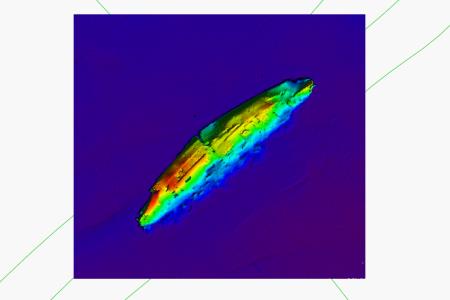 New sonar imagery of the RMS Lusitania
New sonar imagery of the RMS Lusitania
The wreck has been the focus of much investigation, research and analysis over the past century, and was protected by a State underwater heritage order in 1995.
North American businessman Gregg Bemis, who acquired the wreck of the Cunard liner in the 1960s, signed over ownership of the wreck to the Old Head of Kinsale Lusitania Museum at a ceremony at the Old Head of Kinsale in Cork in May of this year.
The “deed of gift will not become effective immediately to protect the local museum committee’s efforts to raise funds from government departments and State agencies.
At the signing, Mr Bemis said that he hoped the Old Head of Kinsale Lusitania Museum Committee would continue investigating the reasons for the second explosion which caused the liner to sink in just 18 minutes. He has long suspected that it was because the ship was carrying war munitions.
Minister for Culture, Heritage and the Gaeltacht Josepha Madigan and junior environment minister Sean Canney congratulated the authors when marking its publication on Thursday evening.
They said the book was “an excellent example of two government departments working in partnership to bring together expertise in archaeology, history and marine mapping while also highlighting Ireland’s leading role in seabed mapping and the promotion of our underwater cultural heritage”.
Scans by the national seabed survey’s INFOMAR project has provided imagery for how the shipwreck looks on the seafloor for the book, and the work also documents other first world war losses off the Irish coast.
“This very readable and meticulously researched book will be an essential work of reference for all interested in heritage studies and maritime affairs for many years to come,”Ms Madigan said.
RMS Lusitania - The Story of a Wreck is available from the Government Stationery Office and bookshops at €20.
Woman Appeals For Help To Bring Fiancé Paralysed After Lusitania Dive Back To Canada
A woman is appealing for help to bring her fiancé back home to Canada after he was paralysed following a diving incident at the Lusitania wreck last month.
As previously reported on Afloat.ie, a man was airlifted to hospital and later transferred to University Hospital Galway’s specialist decompression unit after he took ill during a diving expedition at the wreck site off the Old Head of Kinsale.
It’s since emerged that the casualty, James (Kim) Martin, was left with near total paralysis in the aftermath of the incident on Thursday 8 August.
According to The Irish Times, the experienced diver had been due to marry Kristin Chadwick the week after his trip to Ireland. Chadwick first learned of what happened to her fiancé via an online news search.
Within days she was at his bedside and remained in Galway while Martin recovered from a number of serious complications. He is now able to communicate and has “limited use of his upper body” but needs a respirator to breathe.
Now Chadwick is trying to raise $100,000 in a crowdfunding campaign to being her partner back to Canada by air ambulance for long-term rehab.
The Irish Times has much more on the story HERE.
Courtmacsherry RNLI was among the search and rescue agencies who responded yesterday morning (Thursday 8 August) to reports that a man had taken ill during a diving expedition to the wreck of the Lusitania.
As reported by The Irish Times, it is suspected that the diver, one of a group of eight, developed the bends as he returned to the surface from the wreck site some 18km off the Old Head of Kinsale.
The Naval Service vessel LÉ George Bernard Shaw diverted from patrol in the area and sent a team to bring the casualty on board, from where he was airlifted to hospital.
Later the casualty was transferred from Cork University Hospital to University Hospital Galway, which has a decompression unit.
As the emergency operation wound down, Courtmacsherry RNLI’s all-weather Trent class lifeboat Frederick Stormy Cockburn received another Mayday call, to a 30ft yacht in difficulty off the Seven Heads coast.
The lifeboat was at the scene within 20 minutes and proceeded to tow the stricken vessel back to the safe surrounds of Courtmacsherry Pier.
Commenting on the morning’s callouts, Courtmacsherry lifeboat operations manager Brian O'Dwyer praised all the crew for their professionalism and fast response.
Elsewhere, shortly after 1pm, Crosshaven lifeboat volunteers were called to a medical evaluation from Spike Island in Cork Harbour.
According to Crosshaven RNLI, crew member Aoife Dinan performed casualty care until paramedics arrived, having been brought to the Island by the Port of Cork RIB.
The Irish Community Air Ambulance also landed on the island along with Crosshaven Coast Guard.
“Very sadly, the male casualty, who was a foreign visitor, was declared deceased,” said press officer Jon Mathers. “Our sympathies are with the family of the deceased man; may he rest in peace.”
The US businessman owner of the Lusitania wreck off the West Cork coast has gifted it to a local heritage group planning a new museum around the historic vessel, as the Irish Examiner reports.
Gregg Bemis signed over the wreck to the operators of the Lusitania Museum and Old Head Signal Tower in Kinsale, in the hopes of continued efforts to discover what really happened when it was sunk by a German U-boat 104 years ago yesterday, 7 May.
The multi-millionaire had owned the Lusitania since the 1960s and used his own fortune to fund numerous exploratory dives over the years.
Many of these have been fruitful in recovering artefacts, such as two of the ship’s telegraphs in 2016 and 2017 respectively.
But the 91-year-old businessman believes the question of what caused a mysterious second explosion on the ship when it went down still needs to be solved — contrary to allegations made in a National Geographic documentary in 2012.
Bemis has also been at odds with the State over its strict licensing rules for wreck dives — and the Lusitania’s new owners hope the Government will relax these rules to encourage their own planned research and recovery efforts.
It’s intended that many items recovered from the Lusitania will take pride of place in a ‘living museum’ in the area dedicated to the ocean liner’s remarkable story.
Dungarvan diver Eoin McCarry, a friend of Bemis, said: “It’s like as if the Lusitania is coming home.”
The Irish Examiner has more on the story HERE.
Public Set To See Restored Lusitania Deck Chair At Blasket Islands
#Lusitania - A deck chair recovered from the wreck of the Lusitania by Blasket islanders and restored a century later is planned for public display, as RTÉ News reports.
Master craftsman Pat Broderick says he was able to save most of the original timber from the beech frame, and replaced the rattan seat with the same material woven in identical fashion.
Broderick’s handiwork will shortly be put on display by the Office of Public Works, either at the Blasket Centre in Dunquin or in the restored home of Tomás Ó Criomhthain on Great Blasket Island.
The deckchair was taken from the water with other flotsam and jetsam by islanders on Great Blasket not long after the Lusitania was torpedoed off Kinsale in May 1915.
It was used as a fireside chair for almost four decades before the island was evacuated in 1953, when it went into storage before the Blasket Centre received it as a donation.
RTÉ News has more on the story HERE.
Sinking of the Lusitania Marked by Kinsale Ceremony
A ceremony took place at the Old Head of Kinsale in Cork at the weekend to commemorate the sinking of the Lusitania and its 1,191 victims 103 years ago.
The ocean liner was torpedoed at 2.10pm on 7 May 1915 during WWI, 18km off the Old Head.
A memorial perforated picture installation was unveiled on the headland by Fred Graepel, whose company donated the installation.
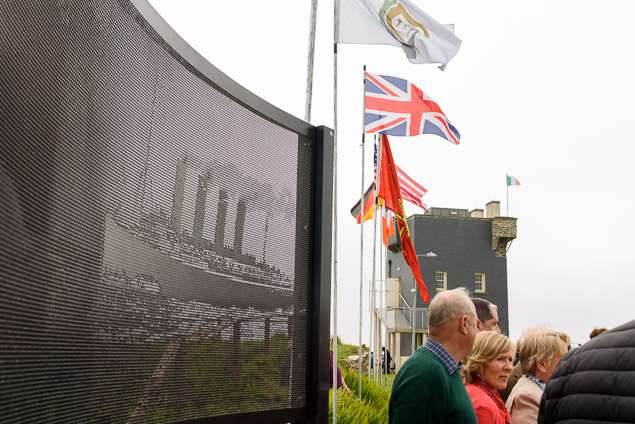
Local historian Paddy O'Sullivan gave a talk on the Lusitania, while a lament was also played.
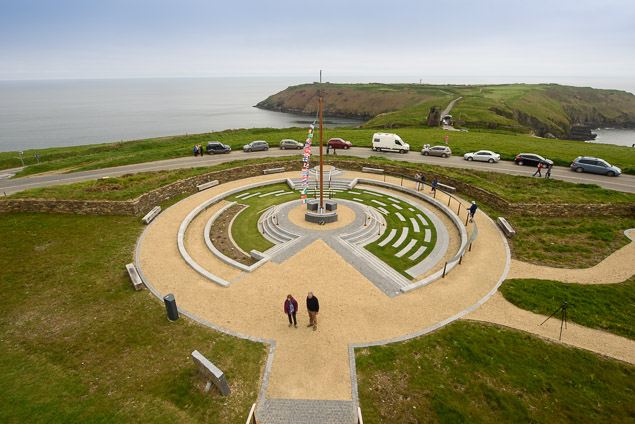
The installation is located adjacent to a restored lookout tower and a Lusitania memorial on the headland.
Chairman of the Lusitania Museum, JJ Hayes, described seeing steamships passing by the headland and the cliffs when he was a boy.


